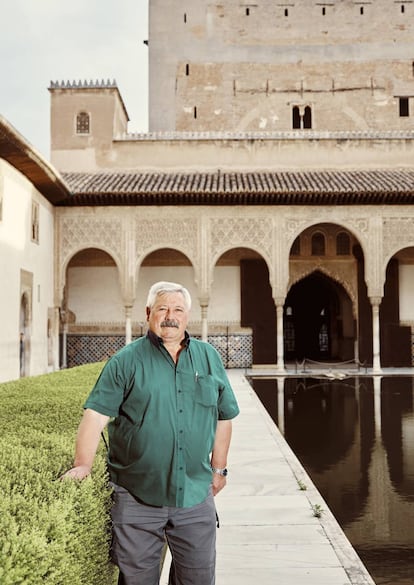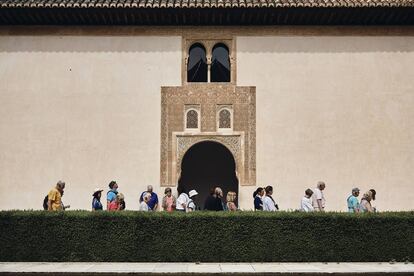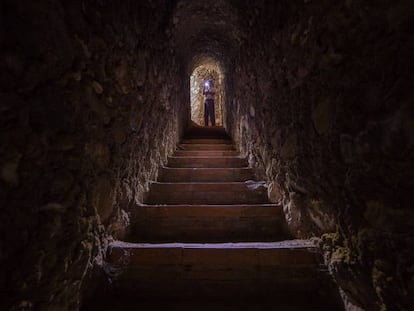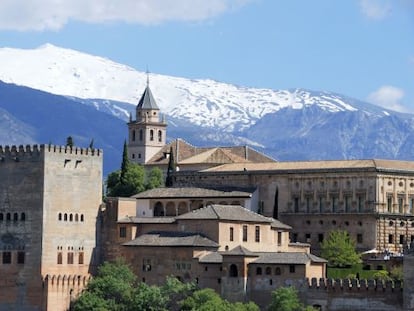The Alhambra’s own constant gardener
For 40 years, Paco García Montes has been taking care of the sweeping green spaces at Granada’s world-famous Islamic palace complex. Before retiring, he shares anecdotes about smart-alecky tourists and killer bugs


In the gardens of San Francisco, along the Alhambra’s Calle Real street, there is a fragrance of honey. It lingers among the rose bushes, the cypresses and the palm trees in this corner of Granada’s famous palatial complex.
“The other day, a tourist asked me where we had the bee hives,” says veteran gardener Paco García Montes, 61. “I was about to explain that there are none in this area, and then I realized that what she was smelling was the myrtle.” And he indicates the tiny white flowers growing beneath the roses.
García has been working for more than 40 years at the Alhambra gardens, which cover 11 of the 130 hectares of land that also encompasses vegetable patches and forests, and which are tended to by 40 gardeners divided into three zones – the Partal, Generalife and Secano.

García is the head gardener of the Secano section, so-called because it was once a dry wasteland. “I got the job at the age of 17 through a neighbor,” he recalls. “At that time, there was scarcely any machinery. We had one chainsaw for the whole of the Alhambra. Everything was cut with scissors and dug out by hand.”
García is planning to retire at the end of this year. He says that he will spend his time looking after the vegetable garden at his home in Huétor de Santillán, 15 kilometers from the Alhambra. But for now, the work is all-absorbing. Pruning, watering, weeding – every month entails a different set of chores. In May and June, for example, the flowers get changed as they die off. And this process is repeated at the end of the fall, with a total of 80,000 specimens planted, 50,000 of which are grown in the Alhambra’s own greenhouses.
The gardeners also have to deal with the pests and diseases that threaten the 500-odd plant species. Right now the red weevil, which kills palm trees, is the main pest. García says that getting rid of the weevil is hard work, but he recalls with sadness an even worse killer, Dutch Elm Disease. This particular scourge arrived in Spain in the 1980s and destroyed the Alhambra’s elms at the start of the 1990s. “They were huge trees,” he says. “We tried everything we could to save them. We put in a drip system filled with insecticide, we surrounded them with quicklime, but nothing worked.”

The gardeners work under the gaze of more than 8,000 visitors that pass through the palace every day, 365 days of the year. García laughs as he explains that sometimes people stop to offer advice. “Everyone thinks they know about plants,” he says, recalling one incident in the Arrayanes Courtyard, where the hedges had gotten out of hand and had to be pruned right back to the bare branches. Some of the visitors were upset with the result and didn’t hesitate to let the gardeners know. “They called us all kinds of names that day,” says García.
Catuxa Novo, a landscape engineer and head of the Alhambra’s green areas department, explains that the concept the Arabs had of green spaces was completely different to that of the Spanish. “For them, coming from the desert, a garden was the image of paradise,” she says.
Here, water is the main element linking one area to the next through ponds, fountains, cisterns and canals. And the palace also has its origins in water. “It is thought that the Alhambra could be built thanks to the fact that water was brought in,” says Novo.

Nowadays, the water comes from the Darro River through a tunnel built in the 1940s that follows the six kilometers of the original channel of the Royal Acequia – the royal canal – that is currently being restored.
Another project underway is the restoration of the vegetable gardens in the Generalife, the only ones within a palatial enclosure that have been in use from the start. Every project involves a group of experts who study documentary evidence, including pictures and travelers’ tales, as well as analyses of pollen found in archeological remains. Some projects reflect the passage of time in a certain area, while others focus on a specific period.
Another development in the last 10 years is the gradual switch from the use of chemical products to more organic methods. “In the 1990s, we used liters and liters of herbicides, like it was water,” says Paco García. Novo adds: “An environment that is free of phytochemicals means the ecosystem can be much richer, more diverse and it can regulate itself.”
Life has returned to the ponds where visitors can now see frogs, dragonflies and Iberian ribbed newts. There are around 160 animal species, from mammals to birds, reptiles, amphibians and fish, who are keeping the tiger mosquito away from the Alhambra grounds.
“We have a rich fauna that eliminates mosquitoes naturally,” says Novo. “There is no need to spray.” When pests need to be controlled, predators who feast on them are released into the environment. This is usually done at night, as the workers need to wear eye-catching overalls and, according to García, this is distracting for the visitors. The gardener adds that some of his colleagues do not much enjoy this nocturnal job. “They say there is a ghost on the premises, and they get scared,” he says. He, on the other hand, loves to spend time alone here. “It’s a real luxury.”
English version by Heather Galloway.

